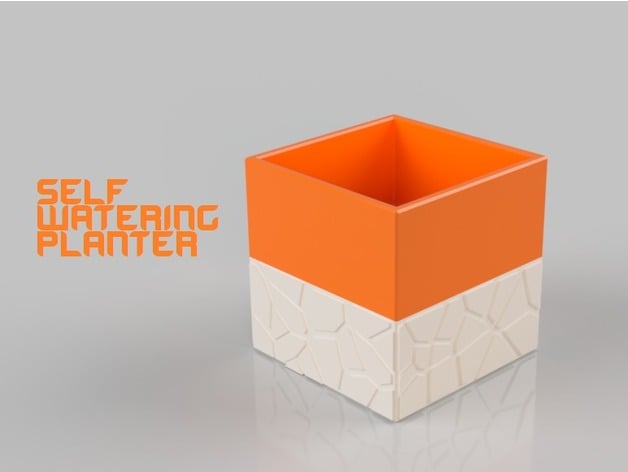
Self-Watering Planter
thingiverse
Update 12/11/2017 Both reservoirs and planters have been updated to eliminate supports entirely. The planter was printed 1% larger than the reservoir. Due to unauthorized listings on Etsy, I added my logo and Thingiverse page into the reservoir to deter future listings. This is a two-part self-watering planter that teaches students about plants as well as capillary action through hands-on experience. The resevoir holds water, which is then drawn into the soil by cotton strings. The purpose of this project is to educate students and encourage exploration. More Planters Bird House Planter Self-Watering Planter 2 Self-Watering Planter 3 Voronoi Planter Find me on: How I Designed This I used Autodesk Fusion 360 as my design software. I began designing the bottom piece first, creating a 100 mm square and extruding it 50 mm high. Then, I shelled it inward by 5 mm. Next, I made a sketch at the top and extruded it to form a rim. Next, I added a new component and created a 50 mm tall square on top of the last piece. I then extruded a square inside the piece and used a circular pattern sketch to create the holes. Finally, I employed a voronoi sketch generator plugin to generate the voronoi patterning on the bottom piece. Custom Section Project: Self-Watering Voronoi Planter Overview: The objective of this project is to introduce students to botany and hydroponics in an engaging way. Students will also learn about capillary action, making it suitable for elementary and middle school students in a science or biology class. This project requires no prior knowledge or skill level; anyone can participate. Lesson: Once you have printed the self-watering planter for your students, demonstrate how it works by tying cotton strings to the holes in the top piece of the planter. Make sure the strings are long enough to reach the bottom of the planter. Wet the strings and fill the bottom piece halfway with water. Fill the top piece with soil, plant seeds, and water the soil thoroughly. Capillary action in the string will replenish the soil with water. Place the planters by the window sill and let the seeds germinate while teaching your students about photosynthesis and germination. The depth of these topics is up to you. The type of seeds used for this project is also up to you; just remember to check the water levels every few days. Duration: The duration of this lab depends on how quickly the seeds germinate and grow, plus the time it takes to print the planter. This will take a few weeks but requires minimal effort. Rubric and Assessment: Grading students is up to the instructor's discretion. I recommend grading them based on the health of their plant as well as a quiz on what they learned from the project.
With this file you will be able to print Self-Watering Planter with your 3D printer. Click on the button and save the file on your computer to work, edit or customize your design. You can also find more 3D designs for printers on Self-Watering Planter.
